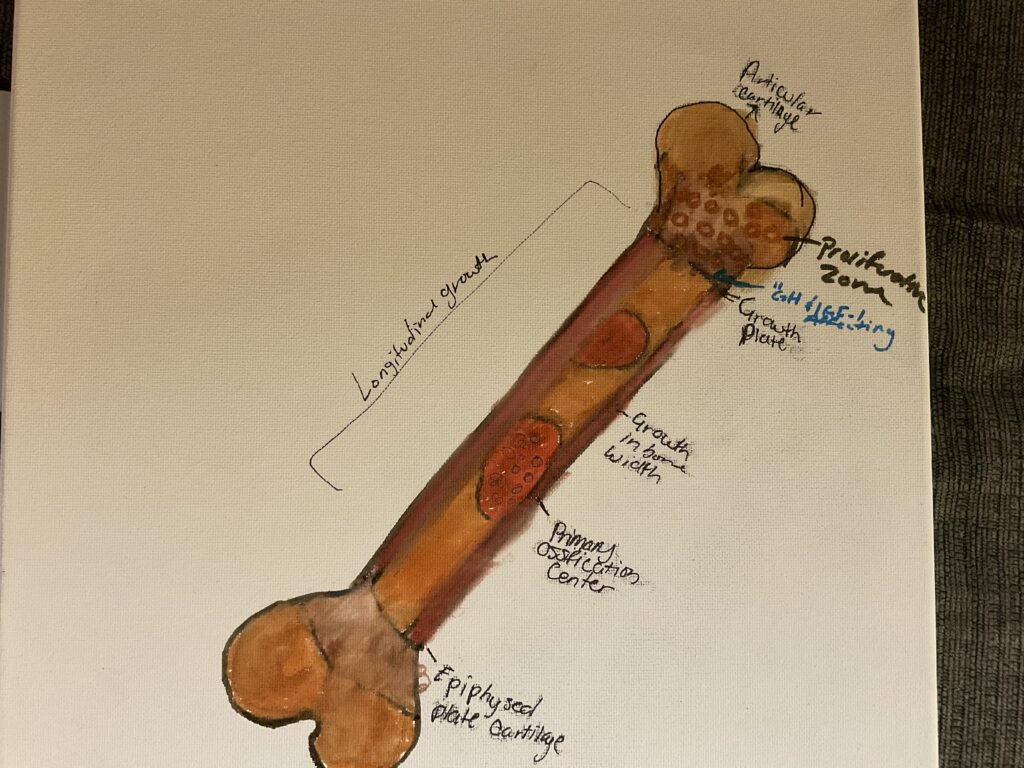
The human skeleton undergoes profound changes during puberty, driven by hormonal regulation at the growth plates. This STEAM project visualizes these processes through an artistic representation of a long bone, highlighting the key areas involved in growth and development. By combining art and science, the project bridges complex biological concepts with creative expression.Bone growth during puberty occurs primarily at the growth plates, specialized cartilage structures at the ends of long bones. These plates facilitate endochondral ossification, a process in which cartilage is replaced by bone tissue. The artwork focuses on several critical areas: the growth plate, primary ossification center, and epiphyseal cartilage.These structures are regulated by growth hormone (GH), insulin-like growth factor-(IGF-1), and sex hormones such as estrogen and testosterone. As Racine and Serrat(2020) explain, IGF-1 directly stimulates chondrocyte activity within the growth plate, enabling both proliftion and hypertrophy-key steps in bone €. gation.The accompanying artwork provides a visual interpretation of these processes. The labeled sections highlight the growth plate’s central role in longitudinal bone growth. The “Primary Ossification Center” and “Epiphyseal Plate Cartilage” are focal points for hormonal regulation. For example, growth in bone width occurs through the activity of osteoblasts and osteoclasts, which are indirectly influenced by hormonal changes.The warm tones and detailed labeling ensure clarity, making the scientific concepts accessible to a broader audience.This artistic piece aligns closely with the findings of Racine and Serrat (2020), who emphasize the role of IGF-1 in stimulating cellular activity in the growth plate. It also integrates insights from Mauras et al. (2022), which discuss the clinical management of growth disorders during puberty. By including these perspectives, the artwork reflects the importance of hormonal balance in normal skeletal development and its disruption in conditions such as growth hormone deficiency.The artwork provides a platform for understanding how different factors contribute to bone growth. The visual clarity of the “Growth in Bone Width” label and the differentiation of zones in the growth plate allow viewers to conceptualize both the macroscopic and microscopic aspects of bone development. Adding arrows or annotations showing the influence of GH and IGF-1 would further connect the art to the biological processes described in the research.This STEAM project illustrates the biological complexity of bone growth during puberty through a creative lens. By combining findings from Racine and Serrat (2020) and Mauras et al. (2022) with detailed artwork, the project communicates the significance of hormonal regulation in the growth plate. The final piece serves as an educational tool, highlighting the interplay between science and art in fostering a deeper understanding of human growth.
Mauras, N., Ross, J., & Mericq, V. (2022). Management of growth disorders in puberty: GH, gnrha, and aromatase inhibitors: A clinical review. Endocrine Reviews, 44(1), 1–13. https://doi.org/10.1210/endrev/bnac014
Racine, H. L., & Serrat, M. A. (2020). The actions of IGF-1 in the growth plate and its role in postnatal bone elongation. Current Osteoporosis Reports, 18(3), 210–227. https://doi.org/10.1007/s11914-020-00570-x
(In progress photo)

